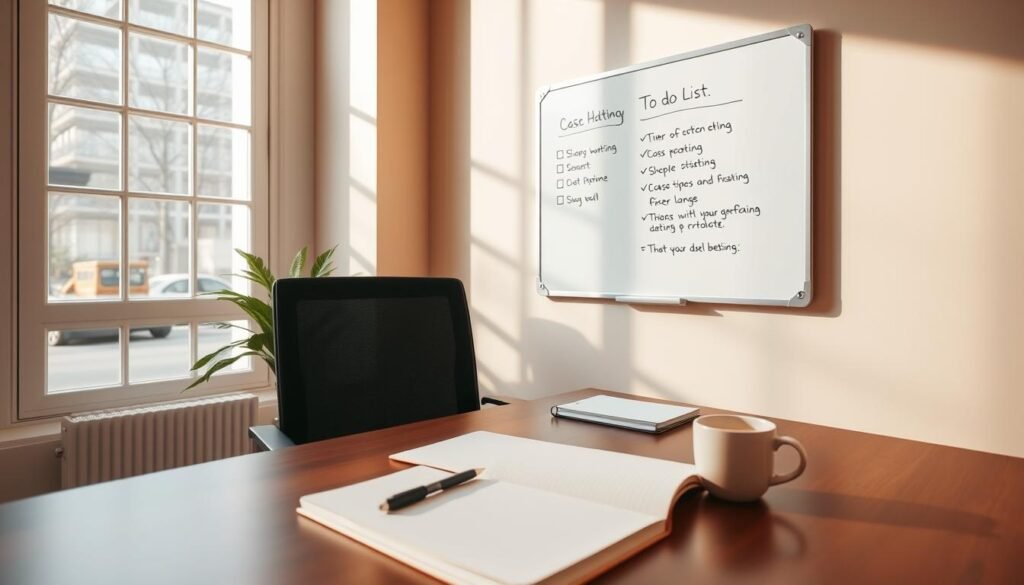Did you know that the habits formed during middle school can shape a student’s future success? This transitional period is more than just a stepping stone to high school—it’s a critical time to develop skills that last a lifetime.
According to a University of Chicago study, students who achieve a 3.5 GPA in middle school are 50% more likely to succeed in college. This highlights the importance of building strong academic and organizational habits early on.
The 45-minute framework is designed to help students balance their growing responsibilities. It’s not just about academics; it’s about fostering executive function skills, grit, and a growth mindset. These qualities are essential for navigating the challenges of school and beyond.
By dedicating just 45 minutes after school to focused tasks, students can create a foundation for long-term success. This approach ensures they stay on track while still having time for other activities.
Key Takeaways
- Middle school is a critical period for developing lifelong skills.
- A 3.5 GPA in middle school increases college success rates by 50%.
- The 45-minute framework helps balance academics and responsibilities.
- Executive function skills are essential for future success.
- This routine builds grit and a growth mindset.
Why a Study Routine is Essential for Middle School Success
Navigating the challenges of middle school requires more than just academic effort. With multiple teachers and conflicting schedules, students often face organizational hurdles. This can lead to missed assignments and added stress.
Poor habits can have serious consequences. Disengagement, test anxiety, and gaps in readiness for high school are common outcomes. Building strong habits early can prevent these issues and set the stage for long-term success.
During adolescence, the brain undergoes significant development, particularly in executive functions like planning and self-control. This makes it the perfect time to focus on time management and organizational skills.
One common challenge is the “assignment hide and seek” phenomenon with LMS platforms. Students often struggle to track tasks across different systems, leading to confusion and missed deadlines.
Metacognition, or thinking about one’s own learning, is a key differentiator between passive and active learners. By reflecting on their study methods, students can identify what works best for them and improve their efficiency.
Setting Up Your Study Space
Creating a productive workspace can transform how you approach your tasks. A well-organized area helps you stay focused and manage your time effectively. According to a Katy ISD case study, students with organized spaces improved assignments completion by 37%.
Choosing the Right Location
Pick a quiet spot with minimal distractions. Natural light and comfortable seating can boost your focus. Adding baroque music or lo-fi beats at 60 BPM can also enhance concentration, as found by Research.com.
Organizing Your Materials
Use color-coded systems to categorize your study tools. Neuroscience shows this boosts information retention by 29%. Keep a planner handy to track tasks and deadlines. Ricky’s red folder system is great for urgent assignments.
Consider a “technology basket” to manage devices and reduce distractions. Handwritten notes are also more effective than digital ones, according to research by Pam Mueller and Daniel Oppenheimer. Finally, conduct weekly 15-minute organizational checks, like those at Katy Junior High, to keep your space tidy and efficient.
Creating a Daily Study Schedule
Breaking your day into manageable chunks helps you stay focused and productive. A well-planned schedule ensures you tackle all your tasks without feeling overwhelmed. Start by allocating specific time slots for each subject, ensuring you cover all areas of your curriculum.
Allocating Time for Each Subject
Begin by mapping out a 45-minute template: 25 minutes of focused work, followed by a 5-minute break, and ending with a 15-minute review. This method, inspired by the Pomodoro Technique, can boost productivity by up to 40%. Use backward planning from test dates to prioritize subjects that need more attention.
Lena’s color-coded math sign system is a great example of saving time. Assigning specific colors to different topics helps you quickly identify and focus on key areas. This approach not only organizes your time management but also enhances retention.
Incorporating Breaks
Short breaks are essential for maintaining focus and energy. Movement breaks, like stretching or a quick walk, are especially beneficial for kinesthetic learners. These pauses allow your brain to recharge and improve overall efficiency.
Introduce “buffer zones” in your schedule to account for unexpected delays. This flexibility ensures you stay on track even when interruptions occur. By balancing work and rest, you create a sustainable routine that supports long-term success.
Effective Study Techniques for Middle School
Mastering effective techniques can make learning more engaging and productive. By focusing on proven strategies, you can improve retention and make the most of your time. These methods are designed to help you stay organized and confident in your academic journey.
Active Reading and Note-Taking
Active reading involves interacting with the material to understand it better. One effective method is the “question bombardment” technique. As you read, ask yourself questions about the content. This keeps your mind engaged and helps you retain key information.
Taking notes is another essential skill. The Cornell Notes system, for example, has been shown to improve retention by 22%. This approach divides your page into sections for main ideas, details, and summaries. It’s a simple yet powerful way to organize your thoughts.
Self-Testing and Retrieval Practice
Self-testing is a proven way to reinforce learning. Using duplicated study guides, you can practice recalling information without looking at the answers. This method, based on the “Make It Stick” methodology, strengthens memory and boosts confidence.
Digital tools like Quizlet can also enhance your test preparation. By creating flashcards from your Schoology materials, you can review key concepts efficiently. For visual learners, Ricky’s map completion strategy is a great way to connect ideas and improve understanding.
For complex subjects, concept mapping tools like Coggle or Miro can help you visualize relationships between topics. These techniques not only make learning more interactive but also ensure you’re fully prepared for exams.
Managing Your Time and Tasks
Effective time and task management can significantly boost productivity and reduce stress. With multiple responsibilities, staying organized is key to success. Using the right tools and strategies can make a big difference.
Using a Planner
A dedicated planner is one of the most effective tools for staying on top of your tasks. Research shows that students using planners complete 89% more homework. Whether you prefer digital tools like Google Tasks or analog systems like the Bullet Journal, consistency is key.
For those using LMS platforms like Canvas or Schoology, integrating your planner with these systems can streamline assignment tracking. Katy Junior High’s peer-sharing initiative, known as the “secret study weapon,” encourages students to collaborate and stay accountable.
Prioritizing Tasks
Not all tasks are created equal. The Eisenhower Matrix is a great way to prioritize. Adapt it by categorizing assignments into urgent, important, and less critical tasks. This helps you focus on what truly matters.
Another effective method is “homework triage.” Use red, yellow, and green tags to label tasks based on priority. This visual system simplifies decision-making and ensures you tackle the most critical steps first.
By combining these strategies, you can manage your time effectively and reduce overwhelm. Small, consistent efforts lead to long-term success.
Building Consistency and Accountability
Building habits that stick requires consistency and accountability. A structured approach helps students stay on track and achieve their goals. By following clear steps, they can develop skills that last a lifetime.
Establishing a Routine
Start with a 3-phase implementation plan. In week one, focus on setting up your system. Weeks two and three are for adjustments, while weeks four to six aim for mastery. This gradual approach ensures long-term success.
Introduce “study contracts” to foster accountability. These agreements between parents and students include measurable goals and regular check-ins. This method keeps everyone on the same page and promotes responsibility.
Seeking Support When Needed
Don’t hesitate to ask for help. Use Sharon Ratliff’s sticky dot self-assessment method to evaluate progress. This simple tool helps identify areas for improvement and encourages self-reflection.
Consider academic coaching or tutoring based on your needs. A decision flowchart can guide you in choosing the right support. For direct assistance, use a script to approach teachers confidently and effectively.
By taking control of your learning journey, you can build habits that lead to success. Consistency and accountability are the foundation of long-term achievement.
Conclusion: Mastering Your Study Routine
Developing effective habits now can pave the way for long-term achievement. The 45-minute framework helps build study skills that make a difference in your academic journey. By focusing on time management and organization, you’ll gain the confidence to tackle challenges in school and beyond.
These skills are transferable, preparing you for advanced courses and future goals. Alumni from Katy ISD and Chicago Public Schools credit this approach for their success. To get started, download our free 21-day habit tracker and try the My Available Time exercise today.
FAQ
Why is a structured after-school plan important for academic success?
A structured plan helps students manage their tasks efficiently, reduces stress, and improves retention of material. It builds habits that lead to better performance in school.
How can I choose the best location for my study space?
Pick a quiet, well-lit area free from distractions. Ensure you have all necessary materials like notebooks, pens, and textbooks within reach to stay focused.
What’s the best way to organize study materials?
Use folders, binders, or digital tools to categorize subjects. Label everything clearly and keep your workspace tidy to avoid wasting time searching for resources.
How much time should I allocate for each subject?
Spend 20-30 minutes per subject, depending on difficulty. Adjust based on assignments or upcoming tests, and always prioritize tasks that need immediate attention.
Why are breaks important during study sessions?
Short breaks every 20-30 minutes help refresh your mind, improve focus, and prevent burnout. Use this time to stretch or relax briefly.
What are some effective techniques for active reading?
Highlight key points, take concise notes, and summarize paragraphs in your own words. Asking questions while reading also enhances understanding.
How can self-testing improve my learning?
Self-testing reinforces memory and identifies areas needing review. Use flashcards, practice quizzes, or teach the material to someone else for better retention.
How do I prioritize tasks effectively?
List all assignments and rank them by deadlines and importance. Tackle the most challenging tasks first when your energy levels are highest.
What’s the benefit of using a planner?
A planner helps track deadlines, manage time, and stay organized. It ensures you don’t miss assignments and can plan ahead for projects or tests.
How can I build consistency in my study habits?
Stick to a daily schedule, set specific goals, and reward yourself for completing tasks. Over time, this builds a routine that becomes second nature.
When should I seek support for my studies?
Reach out to teachers, parents, or a tutor if you’re struggling with a subject. Joining study groups can also provide motivation and clarity on difficult topics.









